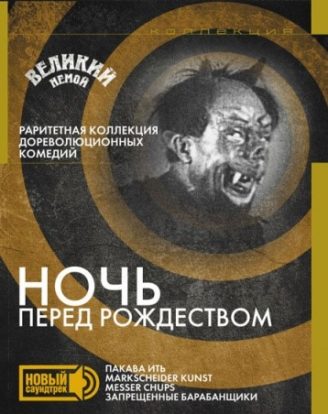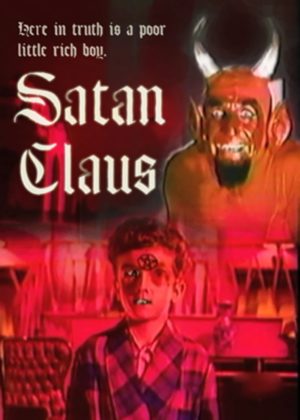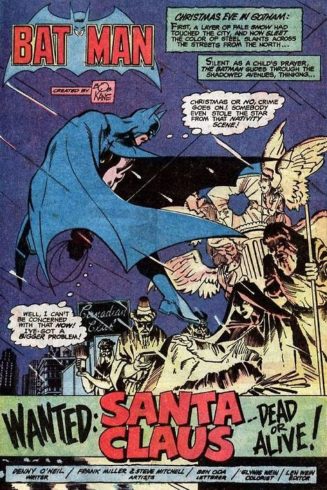My Christmas posts are among the most consistently popular on this site, so here’s another. Included are short takes on three films, a couple short stories and essays, a TV special and a comic book, all of them holiday themed. None in my view are worthy of full-length reviews, but are deserving, at least, of the brief mentions that follow. Enjoy!
 CHRISTMAS EVE (NOCH PERED ROZHDESTVOM) is a 41 minute silent from 1913 that’s significant as the first attempt at bringing Nikolai Gogol’s 1831 tale THE NIGHT BEFORE CHRISTMAS to the screen, and as one of the earliest films made by the pioneering Russian animator Wladyslaw Starewicz (1882-1965). Subsequent film adaptations of THE NIGHT BEFORE CHRISTMAS include the 1961 EVENINGS ON A FARM NEAR DIKANKA, whose broadly comedic take on the material was directly foreshadowed by Starewicz.
CHRISTMAS EVE (NOCH PERED ROZHDESTVOM) is a 41 minute silent from 1913 that’s significant as the first attempt at bringing Nikolai Gogol’s 1831 tale THE NIGHT BEFORE CHRISTMAS to the screen, and as one of the earliest films made by the pioneering Russian animator Wladyslaw Starewicz (1882-1965). Subsequent film adaptations of THE NIGHT BEFORE CHRISTMAS include the 1961 EVENINGS ON A FARM NEAR DIKANKA, whose broadly comedic take on the material was directly foreshadowed by Starewicz.
The story involves the devil, garbed in what looks a monkey costume and glowering mask, stealing the moon (which here takes the form of a lighted sickle). From there he disrupts the festivities of a peasant family on Christmas Eve until one of the family members, the love-struck Vakula, gets the upper hand. All this is as in the Gogol’s text, but the narrative is fragmented to an obnoxious degree. What’s ultimately most striking about this slight film are the elaborate animated special effects of a type that Starewicz helped pioneer, particularly the sight of the devil shrinking down to insect size and being put in the pocket of a normal-sized man—an effect captured in a single shot.
Starewicz turned out another holiday-themed film in 1913, the seven minute INSECTS’ CHRISTMAS (ROZHDESTVO OBITATELEY LESA). It’s a stop motion extravaganza in which a Santa Claus ornament climbs down from its perch on a Christmas tree and ventures outside, where it spends Christmas with a family of insects and a frog that walks on two legs. The film isn’t much, being aimed squarely at the under-ten set and lacking the sophistication, technical and thematic, that marked out Starewicz’s best films (such as THE CAMERAMAN’S REVENGE and THE STORY OF THE FOX, neither of which are Christmas themed but are well worth your time nonetheless).
“Biggles’ Xmas-Box!” by Captain W.E. Johns is an odd standalone Biggles story, published in The Modern Boy 1934 Christmas issue (and reprinted in the  1999 anthology BIGGLES AIR ACE). For those who don’t know, Biggles was a fictional WWI flying ace who headlined nearly 100 books by the indefatigable Capt. Johns, and quite a few short stories (not to mention the 1986 film BIGGLES, scripted by mi papa—which explains my interest in the series).
1999 anthology BIGGLES AIR ACE). For those who don’t know, Biggles was a fictional WWI flying ace who headlined nearly 100 books by the indefatigable Capt. Johns, and quite a few short stories (not to mention the 1986 film BIGGLES, scripted by mi papa—which explains my interest in the series).
In this Christmas day set story Biggles finds himself in a festive mood, and decides to spread some holiday cheer by dropping a box packed with sausages into a camp of starving German soldiers. If such subject matter seems out of place in the Biggles cannon, you can rest assured that Johns gets down to the expected action derring-do pretty quickly, with our hero’s flight out to the camp interrupted by a German fighter who cares nothing for Biggles’ valiant intentions. In the ensuing dogfight Biggles nearly loses his life, and finds that his Christmas box makes for an extremely handy weapon.
A pretty slight story, admittedly, but one that handily accomplishes its none-too-grand aims. It’s damned entertaining, in short!
Pivoting mightily, we come to “No Offense Intended, But Fuck Xmas!,” a December 28, 1972 essay by the late Harlan Ellison that’s easily the single most vitriolic anti-Christmas screed I’ve ever read. It also happens to bring up a lot of valid points.
According to Ellison, “Christmas is an awfulness that compares favorably with the great London plague and fire of 1665-66,” from which “No one escapes the feelings of mortal dejection, inadequacy, frustration, loneliness, guilt and pity.” In illustrating his thesis Ellison lists the many crimes that took place on Christmas in ‘72 (including abduction, murder and suicide), beaks down A CHRISTMAS CAROL (whose protagonist Scrooge is apparently the only personage in the book with “any character”), and promises to erect a flashing neon sign atop his house that reads “BAH! HUMBUG!”—and furthermore, “any little clown who comes caroling at my door is going to have boiling pitch dumped on him.”
For good measure Ellison revisited the subject of Christmas the following year, in “Oh, Dear, He’s Not Going to Do Xmas Again, Is He?” The previous essay is  reprinted here, along with approximately two pages of fresh ranting, such as: “And don’t give me none of that shit about hearing from people once a year and ain’t that sweet…I don’t want to hear from most of those drips anyhow,” and “if you send me a greeting card, I’ll only roundfile it and call you an asshole.” Agree or not, you have to admire the fierceness with which Ellison makes his points; an irascible curmudgeon he may have been, but a mealy-mouth he definitely wasn’t.
reprinted here, along with approximately two pages of fresh ranting, such as: “And don’t give me none of that shit about hearing from people once a year and ain’t that sweet…I don’t want to hear from most of those drips anyhow,” and “if you send me a greeting card, I’ll only roundfile it and call you an asshole.” Agree or not, you have to admire the fierceness with which Ellison makes his points; an irascible curmudgeon he may have been, but a mealy-mouth he definitely wasn’t.
SATAN CLAUS (1975) is a 3 minute film by the underground auteur J.X. Williams that was made, allegedly, as revenge against a Hollywood theater owner who stiffed him. Williams claims to have included SATAN CLAUS in a children’s Christmas matinee run by the hated theater owner, which reportedly caused a near-riot.
Done entirely without dialogue and incorporating footage from Rene Cardona Jr.’s SANTA CLAUS (1959), it involves a lonely little boy, left behind on Christmas Eve by his selfish parents, inadvertently conjuring up “Satan Claus” via a miswritten note. Satan Claus turns out to be a goof in a devil suit who turns up and seemingly inducts the kid into a coven…or something. Truthfully it’s hard to tell exactly what happens. My recommendation? View Williams’ altogether fascinating 9 minute VIRGIN SACRIFICE (found on the DVD anthology EXPERIMENTS IN TERROR and seemingly all over the internet) in place of this film.
“Wanted: Santa Claus—Dead or Alive!” is a short BATMAN comic from 1980 that was scripted by Denny O’Neil and partially illustrated by a young Frank Miller. It marked Miller’s first-ever experience with the Dark Night, which makes it significant (it was later reprinted in 1989’s COMPLETE FRANK MILLER BATMAN). The setting is Gotham City on Christmas Eve, with Batman discovering that a scumbag named Boomer Katz has gotten a job as a department store Santa. Batman correctly deduces that Boomer has taken the job in order to rob the store, but after a day playing Santa Boomer finds himself overcome by Christmas cheer—which doesn’t impress his outlaw cohorts, who insist on going through with their elaborately planned heist. Luckily Batman is on the case, and swoops in to save the day.
O’Neil and partially illustrated by a young Frank Miller. It marked Miller’s first-ever experience with the Dark Night, which makes it significant (it was later reprinted in 1989’s COMPLETE FRANK MILLER BATMAN). The setting is Gotham City on Christmas Eve, with Batman discovering that a scumbag named Boomer Katz has gotten a job as a department store Santa. Batman correctly deduces that Boomer has taken the job in order to rob the store, but after a day playing Santa Boomer finds himself overcome by Christmas cheer—which doesn’t impress his outlaw cohorts, who insist on going through with their elaborately planned heist. Luckily Batman is on the case, and swoops in to save the day.
The story is done up in the recognizable early 1980s comic book style, although the depictions of Batman bursting through windows and performing feats of particularly acrobatic ass-kicking directly foreshadow Miller’s subsequent work on RONIN and THE DARK KNIGHT RETURNS. Narrative-wise, alas, the story isn’t too invigorating, conclusively demonstrating why it was that Batman needed resuscitating in the latter part of the decade—with Frank Miller, appropriately enough, being the one who did the job.
Those in the mood for an endearingly ridiculous eighties time capsule could do much worse than 1986’s MAX HEADROOM CHRISTMAS SPECIAL. Surely you remember Max Headroom the computerized hologram dude—actually actor Matt Frewer, his appearance distorted by then state of the art video effects—who headlined numerous Coke commercials, a short lived ABC series and an even shorter-lived Cinemax interview program, of which this special was an outgrowth.
 Holiday shows tend to be excruciating affairs (just try sitting through that interminable STAR WARS HOLIDAY SPECIAL), but this one is at least relatively short (40 minutes) and fast moving, with a rudderless, near-psychedelic sequence of events that includes Max on a TV monitor getting pelted with snowballs, chatting with celebrity guest stars like Tina Turner, Robin Williams and Bob Geldof (who looks mighty stoned), and warbling instantly forgettable holiday tunes. There’s also a montage in which Max gives his thoughts on holiday celebrations in different countries (including Russia, “where they think so much of their dissidents they ship them off to a place where it’s Christmas all year ‘round!”), an occasional laugh track and some cheesy animated segues. It’s a bit like an episode of MONTY PYTHON’S FLYING CIRCUS, minus the laughs.
Holiday shows tend to be excruciating affairs (just try sitting through that interminable STAR WARS HOLIDAY SPECIAL), but this one is at least relatively short (40 minutes) and fast moving, with a rudderless, near-psychedelic sequence of events that includes Max on a TV monitor getting pelted with snowballs, chatting with celebrity guest stars like Tina Turner, Robin Williams and Bob Geldof (who looks mighty stoned), and warbling instantly forgettable holiday tunes. There’s also a montage in which Max gives his thoughts on holiday celebrations in different countries (including Russia, “where they think so much of their dissidents they ship them off to a place where it’s Christmas all year ‘round!”), an occasional laugh track and some cheesy animated segues. It’s a bit like an episode of MONTY PYTHON’S FLYING CIRCUS, minus the laughs.
I got a mild kick out of the show, although it’s easy to see why the Max Headroom phenomenon didn’t very long: his stuttering motor-mouthed banter, after all, gets old after about ten seconds.
Finally we have “Anti-Claus,” a 2003 story by Graham Masterton that can be found on his website. It’s everything we’ve come to expect from Masterton, which is to say that it’s lively and nasty, and has a consistently unpredictable narrative.
The protagonist is Jack, a land surveyor stationed in Northern Minnesota, where the “real” Santa Claus apparently once resided. This particular Santa was far different from the jolly fat guy we know, being a psychotic vagabond who performed magical fertility rituals for a very high price that tended to involve Santa–derived, apparently, from Satan—entering peoples’ houses and killing their children, whose heads he then made off with in a large sack. Fascinated by the tale, Jack decides to inspect the burned-out house where Santa/Satan is said to have resided, and there discovers a rusty metal box containing a number of apparently magical keepsakes. Jack unwisely uses those keepsakes in an evocation that causes grass to grow in the middle of winter—and burdens him with a debt to the box’s owner, who as we already know tends to make sure that his debts are always paid off in one way or another.
A decent enough story, but it’s crippled by an overly pat ending, in which (!!!SPOILER ALERT!!!) the centuries-old, supernaturally endowed Anti-Claus is bested and ultimately dispatched by Jack with remarkable ease. Surely Masterton, a 40-plus year veteran of the horror writing trade, can do better than that!
